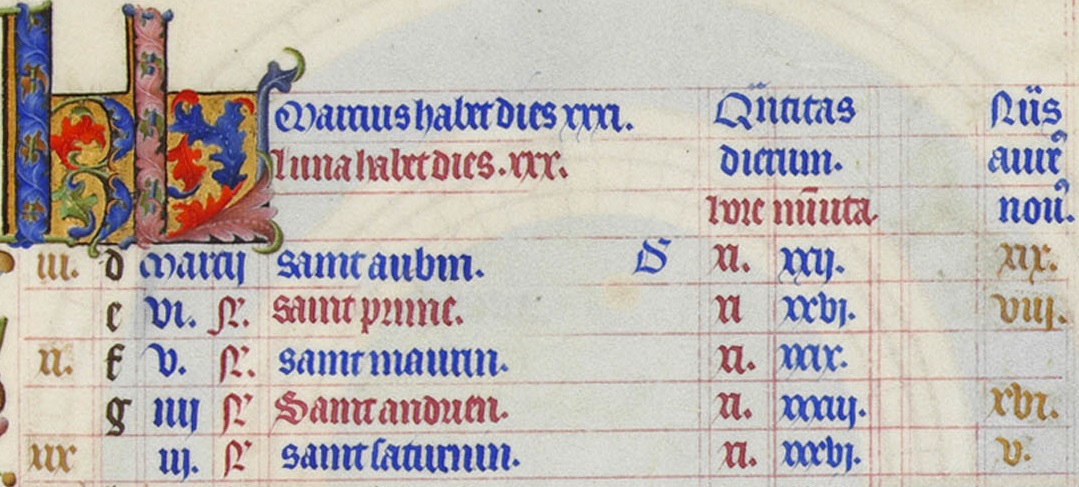Reading the tympanes in the Tres Riches Heures
Consider the calendar miniature for March (link 4). The semicircle ("tympane") on top (shown above) contains an astronomical almanac.
The inner circle lists the days of the month of March (1..31, using an early form of our "arabic" numerals); the outer circle lists the degrees of the zoodiacal signs that fall within the calendar month: 20..30 of Pisces, and 1..19 of Aries. These animals are also depicted in the blue segments in the middle. Now note that the first point of Aries, that of the spring aequinox, has been set at 12 March (in the Julian calendar). There is also a semi-circle with 20 crescents, and inside of this, for the same days, the so-called martyrological letters 'a' to 't'. These count the years of the 19-year cycle (the letter 'j' is omitted - remember "Indiana Jones and the Last Crusade"?). Look for the next letter 10 to 12 days before the previous one. These letters work as Golden Numbers, and for a certain year in the cycle they indicate on which date a New Moon occurs.This is also listed in the Kalendarium on the pages opposite the calendar miniatures in the manuscript (link 5): see the fragment shown above.
The last column "Nu(meru)s aure(us) nov(us)" shows in roman numerals the Golden Numbers (in gold!) corresponding to the martyrological letters in the tympane. These "new" Golden Numbers show that the almanac in the Très Riches Heures was already updated to the astronomical reality of around 1400. The first column however lists the traditional Golden Numbers still actually used in the Computus for Easter (the second column lists the Sunday letters used to find Sundays, in particular Easter Sunday).
Now note that for the last year in the cycle, with the letter 't' and Golden Number xix (19), the new Golden Numbers indicate a New Moon on 1 and on 31 March. The 14th day ("Full Moon") then occurs on 14 March, and since in the new reckoning the Sun was in the first point of Aries on 12 March, this is the first Full Moon of spring, and therefore should be the Easter Moon.
But the Roman Church still used the old Golden Numbers in the first column: here number xix is assigned to the 5th day of March, so this was computed to be the first day of a lunar month in the 19th year of the cycle. The 14th day would then be 18 March: before 21 March which the church used as the canonical date for the begin of spring, so the Full Moon that was computed to occur on 18 March was not an Easter Moon. As we see in Table 1, 17 April would have the Easter Moon according to the church (the New Moon was computed on 4 April, running 4 days behind the real New Moon at 31 March).
The Très Riches Heures demonstrate that it was a well-known problem at the time that the Easter Computus was obsolete (Ref.5). It is therefore understandable that people in the 16th century were angry with the church and started to resist. The incompetence of the Roman Catholic Church to get the calendar in order may have been a factor in the success of the Protestant Reformation. The Gregorian Calendar reform came only in 1582 . This reform modified not only the leap day scheme of the Solar calendar to keep the beginning of spring closer to 21 March: but more importantly it introduced a better Lunar calendar that in the long term keeps in pace with the real Moon, such that Easter will fall in the proper season.

